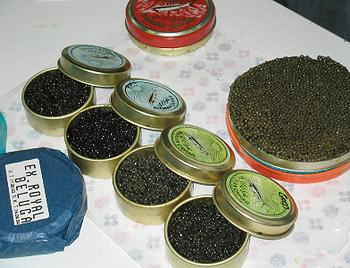根據最新的國際野生動物貿易調查委員會(TRAFFIC)所提出的最新報告,發現在保加利亞和羅馬尼亞持續進行的魚子醬非法交易,威脅多瑙河內瀕臨絕種的鱘魚。

由世界自然基金會(WWF)所委託調查的報告中顯示,歐盟會員國在2000年到2009年所提報的非法魚子醬查獲紀錄,共有14宗來自於保加利亞(5宗案件達27.5公斤)和羅馬尼亞(9宗案件達25公斤)。但保加利亞和羅馬尼亞皆未提報任何非法的魚子醬起獲案件。
根據世界自然保育聯盟(IUCN)的瀕危物種紅皮書(Red List),起源於兩億年前、比恐龍存在更久的鱘魚,其中大部分的品種現在正面臨嚴重的生存威脅。
保加利亞和羅馬尼亞保有歐盟地區野生鱘魚僅有存活的數量,但多瑙河流域的六個自然鱘魚品種中有五個已被列入瀕臨絕種名單,而在多瑙河流域中已禁止捕抓鱘魚。
國際野生動物貿易調查委員會成員、也是此報告主要作者Kecse Nagy說到:「重要的是保加利亞和羅馬尼亞回報並未查獲任何非法魚子醬,既使歐盟會員國登記多起的非法魚子醬起獲皆與這兩個國家有關。」
她說:「雖然查獲的數量並不多,但我們必須留意的是魚子醬非法交易的實際數量可能高出許多,而且任何非法的交易也會對這些受高度威脅的物種造成難以承擔的風險。」
今年5月保加利亞實行一項禁止捕抓鱘魚的法令,該法令相似於在多瑙河對岸的羅馬尼亞河岸所實行的禁令。
WWF鱘魚專家Jutta Jahrl表示:「羅馬尼亞在2006年暫停實行此禁令,但考量多瑙河為保加利亞和羅馬尼亞的邊界河,一旦漁民到對岸去捕魚的話,只有單邊的禁令並無法有效禁止他們的捕魚行為。」
大部份的鱘魚是由海移棲淡水河進行產卵,也就是說當成熟的鱘魚會在淡水河口和沿海一帶生存並且遊到上游去產卵。僅次裡海,黑海是世界上最重要的鱘魚漁場之一。而多瑙河則是黑海主要的供應河和河口之一。因此多瑙河對鱘魚的生存十分重要。
保加利亞的一年禁令計畫要在2012年開始實行,比多瑙河的五年鱘魚捕捉禁令要來得更早。
保加利亞國家農漁業協會的漁場管理主任,Ivaylo Simeonov表示:「依照禁令的規定,將會實行許多措施來維持鱘魚的生存量,舉例來說像是補給魚的數量和監控鱘魚的狀況等。」2012年,也計畫要加強實行禁令並對漁業界團體進行宣導。
2007年羅馬尼亞和保加利亞加入歐盟,Kecse Nagy表示,這使得魚子醬的非法交易更難以查緝或預防,因為歐盟國家之間的魚子醬貨運紀錄,不會登記在華盛頓公約彙整的貿易資料中。
由於這兩個國家的位置,使它們成為裡海非法魚子醬的窗口,而裡海是世界上最重要的鱘魚漁場。
2009年,德國政府查獲魚子醬非法走私到歐盟地區,該些魚子醬標示其源自保加利亞。保加利亞和羅馬尼亞只准許進行養殖魚子醬的交易,但根據同位素檢驗顯示該些魚子醬來自於裡海。
「這顯示出裡海的非法魚子醬借由兩國政府准許魚子醬養殖的規定來進行漂白,使該些魚子醬交易合法化。更重要的是要嚴密地規定魚子醬的產地,以確保非法交易不會對野生鱘魚造成威脅。」Keces Nagy說。
合法交易資料的分析指出,保加利亞水產養殖出口到歐盟國家和其他地區的數量增加許多。
國際野生動物貿易調查委員會建議,羅馬尼亞和保加利亞的捕魚禁令執行單位要提高對非法魚子醬交易的警覺,並加強監督和管控該些非法交易的能力。
Jahrl表示:「歐盟應該要負起訂定魚子醬交易的規範,因為整個歐盟會員國就是羅馬尼亞魚子醬最大的消費國,也是保加利亞的第二大魚子醬消費國。歐盟必需要填補這個非法交易的漏洞,以保鱘魚可免於絕種。」
但Jahrl說:「歐洲的魚子醬消費者對於非法魚子醬交易所帶來的衝擊並不了解,即使是販賣商也不太清楚標示合法魚子醬的規定。重要的是要讓販賣商和消費者不要購買未貼產地標示的魚子醬,這一個簡單的動作將可以有效地防止非法魚子醬的交易。」
有關鱘魚的生存問題,過度捕撈是最重要的原因,但阻斷鱘魚的遷移路線,棲息地的改變,包括像是水力發電和水汙染也是主要因素。
世界鱘魚保育協會警告:多瑙河是歐洲唯一一個地方仍可以保留現已持續減少的鱘魚數量。
這份名為《保加利亞和羅馬尼亞的魚子醬貿易》的報告,是由穆含默德賓薩依德物種保育基金會、德國國會環境基金會和世界野生動物基金會所贊助。
Danube River Sturgeons Victims of Illegal Caviar Trade BUDAPEST, Hungary, November 15, 2011 (ENS) - Persistent illegal trade in caviar involving Bulgaria and Romania is undermining the survival of the endangered sturgeons of the Danube River Basin, finds a new report from the international wildlife trade monitoring network TRAFFIC.
Commissioned by the global conservation organization WWF, the report shows a total of 14 seizures of illegal caviar originating from Bulgaria (27.5 kg in five seizures) and Romania (25 kg in nine seizures) were reported by EU Member States between 2000 and 2009.
Neither Bulgaria nor Romania have reported any illegal caviar seizures.
Originating 200 million years ago, sturgeons have outlasted the dinosaurs, but today most species are Critically Endangered, according to the IUCN Red List.
Bulgaria and Romania host the only viable populations of wild sturgeons in the European Union, but five of the six native sturgeon species in the Danube Basin are listed as Critically Endangered, and sturgeon fishing there has been banned.
"It is of concern that Bulgaria and Romania reported no seizures of caviar, while other EU Member States registered several seizures where those two countries were implicated," said TRAFFIC's Katalin Kecse-Nagy, who authored the report.
"The detected quantities are not very high, but we must bear in mind that the real volume of illegal trade is likely to be considerably higher and any illegal trade poses an unacceptable risk to these highly threatened species," she said.
In May, Bulgaria imposed a fishing ban on sturgeon, which matches a ban on the opposite Romanian bank of the Danube.
"The Romanian moratorium came into force in April 2006, but considering that the Danube serves as a national border between Bulgaria and Romania, a one-sided ban cannot have any impact if fishermen on the other side are still catching the fish," said WWF sturgeon expert Jutta Jahrl.
Most sturgeons are anadromous, meaning that the adults live in estuaries and coastal waters and swim upstream to spawn. The Black Sea is one of the most important sturgeon fisheries in the world, second only to the Caspian Sea. The Danube, as one of the major feeder rivers and estuaries of the Black Sea, is crucial for sturgeons.
Bulgaria's one-year ban precedes a five-year ban on sturgeon catching in the Danube, which is planned to start in 2012.
Ivaylo Simeonov, head of fisheries monitoring at Bulgaria's National Agency of Fisheries and Aquaculture, said "Under the terms of the proposed ban, various activities in support of sturgeon populations will be carried out, for example restocking of fish populations and monitoring of the status of sturgeons."
An information campaign among fishing communities and better enforcement of the ban also are planned for 2012.
In 2007, both Romania and Bulgaria joined the European Union, which Kecse-Nagy says makes any illegal trade in caviar harder to detect and prevent because caviar shipments to EU Member States are no longer recorded in the trade data compiled by the Convention on International Trade in Endangered Species.
Due to their location, the two countries are gateways for illegal caviar trade from the Caspian Sea, the world's most important sturgeon fishery.
In 2009, German authorities seized caviar smuggled into the European Union labeled as Bulgarian farmed caviar. Bulgaria and Romania are only permitted to trade in farmed caviar, but isotope analysis demonstrated the caviar had originated from the Caspian Sea.
"This case demonstrates how permitted caviar farming was exploited to launder illegally sourced caviar into legal trade," said Kecse-Nagy. "This means it is more vital than ever to regulate closely the caviar trade within the region to ensure illicit trade is not posing a threat to wild sturgeons."
Analysis of legal trade data indicates a large increase in aquaculture production in Bulgaria for export into EU countries and elsewhere.
The TRAFFIC report recommends both Romania and Bulgaria raise awareness among enforcement agencies of the illegal caviar trade and strengthen their capacity to control and monitor the trade.
"The EU has a major responsibility to regulate the caviar trade because EU member states are the largest consumer of caviar from Romania and the second largest consumer of caviar from Bulgaria," said Jahrl.
"The EU must close every loophole in order to save sturgeons from extinction," she said.
But Jahrl says European caviar consumers know little about the threat posed by the illegal caviar trade, and even traders know very little about the requirements for labeling legal caviar.
"It is crucial that traders and consumers do not buy unlabeled caviar. This simple act would strike a major blow against the illegal trade," said Jahrl.
For sturgeon survival, overfishing is the biggest cause for concern, but cutting off sturgeon migration routes, habitat alteration, including hydropower, and pollution are further contributing causes.
The World Sturgeon Conservation Society warns that the Danube is the only large river system in Europe where protection of existing but dwindling sturgeon stocks is still possible.
The report, "Trade in Sturgeon Caviar in Bulgaria and Romania," was funded by The Mohamed bin Zayed Species Conservation Fund, Deutsche Bundesstiftung Umwelt and WWF.


